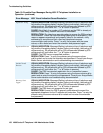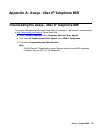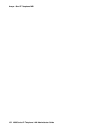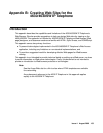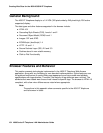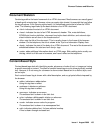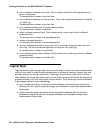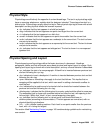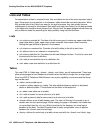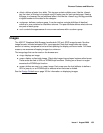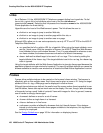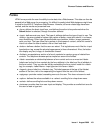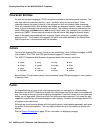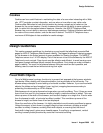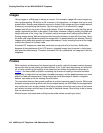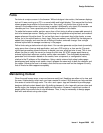
Creating Web Sites for the 4630/4630SW IP Telephone
158 4600 Series IP Telephone LAN Administrator Guide
Lists and Tables
For presentation of data in a logical format, lists and tables are two of the more important sets of
tags. Since space is at a premium in the browser, tables should be used with discretion. While
they provide sets of text, which are easy for the eye to process, they can quickly become
cumbersome if misused in this browser. Both width and height are limited, so the data provided
in the table cells should be short pieces of text. Beyond that, the page designer should come up
with a different model for presenting the data, possibly using lists and divisions.
Lists
● <ol> starts an ordered list. Provides a list with some type of numbering: upper-case letters,
lower-case letters, digits, upper-case roman numerals, lower-case roman numerals.
Setting the type attribute is ignored in the browser.
● <ul> starts an unordered list. Provides a list with bullets to the left of each item.
● <li> adds an item to an ordered or unordered list.
● <dl> starts a definition list. Provides a list with two fields per list item. The first is a term and
the second is the term's definition.
● <dt> adds a new definition term to a definition list.
● <dd> adds a new term definition to a definition list.
Tables
The new HTML 4.0 table tags, <thead>, <tbody> and <tfoot> are all implemented. These tags
allow printed pages to have headers and footers when the table is longer than a single page.
Since the 4630 IP Telephone Web Browser has no print capability, we recommend that these
tags not be used.
● <table> starts a table layout.
● <caption> adds a caption to a table. The align attribute allows a caption to be placed
above or below the table. This attribute has no effect in the telephone.
● <tr> adds a new table row to a table.
● <th> adds a header for some column(s) of a table.
● <td> adds a piece of data for some row(s) and column(s) of a table.
● <thead> defines a set of table header rows. The intent of this tag is to provide a set of
header rows for each printed page. While viewing the page in a browser, the header has
no more effect than the <th> tag. What it provides for the designer is a more logical
breakout of the data. The table’s header area is easily recognizable, since it appears
between the <thead> start and end tags.
● <tbody> defines the main body of a table, when used with the <thead> and <tfoot> tags.



